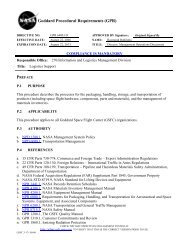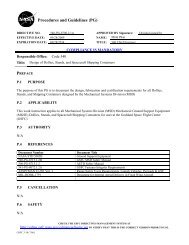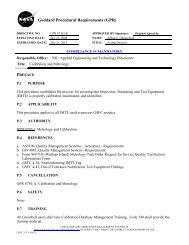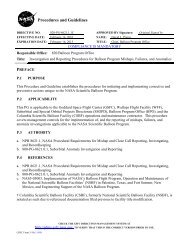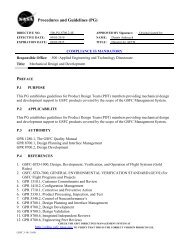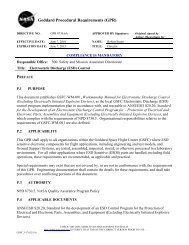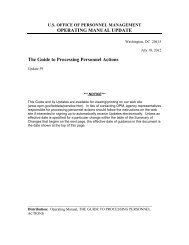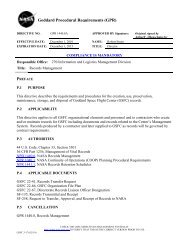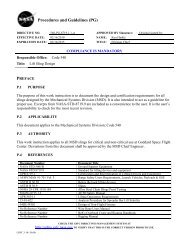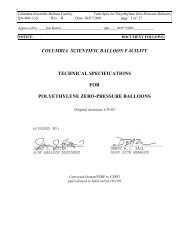ANSI ESD S20.20-2007 - FOIA and eLibrary website! - NASA
ANSI ESD S20.20-2007 - FOIA and eLibrary website! - NASA
ANSI ESD S20.20-2007 - FOIA and eLibrary website! - NASA
You also want an ePaper? Increase the reach of your titles
YUMPU automatically turns print PDFs into web optimized ePapers that Google loves.
<strong>ANSI</strong>/<strong>ESD</strong> <strong>S20.20</strong>-<strong>2007</strong>(This foreword is not part of <strong>ANSI</strong>/<strong>ESD</strong> <strong>S20.20</strong>-<strong>2007</strong>)FOREWORDThis st<strong>and</strong>ard covers the requirements necessary to design, establish, implement <strong>and</strong> maintainan Electrostatic Discharge (<strong>ESD</strong>) Control Program for activities that manufacture, process,assemble, install, package, label, service, test, inspect or otherwise h<strong>and</strong>le electrical or electronicparts, assemblies <strong>and</strong> equipment susceptible to damage by electrostatic discharges greater thanor equal to 100 volts Human Body Model (HBM). This document covers the <strong>ESD</strong> ControlProgram requirements <strong>and</strong> offers guidance for setting up a program to h<strong>and</strong>le <strong>ESD</strong> sensitive(<strong>ESD</strong>S) items, based on the historical experience of both military <strong>and</strong> commercial organizations.References include <strong>ESD</strong> Association, U.S. Military <strong>and</strong> <strong>ANSI</strong> approved st<strong>and</strong>ards for materialproperties <strong>and</strong> test methods. The fundamental <strong>ESD</strong> control principles that form the basis of thisdocument are:A. All conductors in the environment, including personnel, shall be bonded orelectrically connected <strong>and</strong> attached to a known ground or contrived ground (as onshipboard or on aircraft). This attachment creates an equipotential balancebetween all items <strong>and</strong> personnel. Electrostatic protection can be maintained at apotential above a “zero” voltage ground potential as long as all items in the systemare at the same potential.B. Necessary non-conductors in the environment cannot lose their electrostaticcharge by attachment to ground. Ionization systems provide neutralization ofcharges on these necessary non-conductive items (circuit board materials <strong>and</strong>some device packages are examples of necessary non-conductors). Assessmentof the <strong>ESD</strong> hazard created by electrostatic charges on the necessary nonconductorsin the work place is required to ensure that appropriate actions areimplemented, commensurate with risk to <strong>ESD</strong>S items.C. Transportation of <strong>ESD</strong>S items outside an <strong>ESD</strong> Protected Area (hereafterreferred to as “EPA”) requires enclosure in static protective materials, although thetype of material depends on the situation <strong>and</strong> destination. Inside an EPA, lowcharging <strong>and</strong> static dissipative materials may provide adequate protection. Outsidean EPA, low charging <strong>and</strong> static discharge shielding materials are recommended.While these materials are not discussed in the document, it is important torecognize the differences in their application. For more clarification see <strong>ANSI</strong>/<strong>ESD</strong>S541.Any relative motion <strong>and</strong> physical separation of materials or flow of solids, liquids or particle-ladengases can generate electrostatic charges. Common sources of <strong>ESD</strong> include personnel, itemsmade from common polymeric materials, <strong>and</strong> processing equipment. <strong>ESD</strong> damage can occurwhen:i. A charged object comes into contact with an <strong>ESD</strong>S device, orii. An <strong>ESD</strong>S device is grounded while exposed to an electrostatic field.Examples of <strong>ESD</strong>S parts are microcircuits, discrete semiconductors, thick <strong>and</strong> thin film resistors,hybrid devices, printed circuit boards <strong>and</strong> piezoelectric crystals. It is possible to determinedevice <strong>and</strong> item susceptibility by exposing the device to simulated <strong>ESD</strong> events. The level ofsensitivity, determined by testing using simulated <strong>ESD</strong> events, may not necessarily relate to thelevel of sensitivity in a real life situation. However, they are used to establish a baseline ofsusceptibility data for comparison of devices with equivalent part numbers from differentmanufacturers. Three different models are used for characterization of electronic components:HBM, Machine Model (MM), <strong>and</strong> Charged Device Model (CDM).Copyright 2010 by <strong>ESD</strong> Association. Licensed, by agreement, for enterpise-wide use to <strong>NASA</strong>.No other reproduction or transmission in any form is permitted without written permission of the <strong>ESD</strong>A.For inquiries or to report unauthorized use, contact info@esda.org.i



